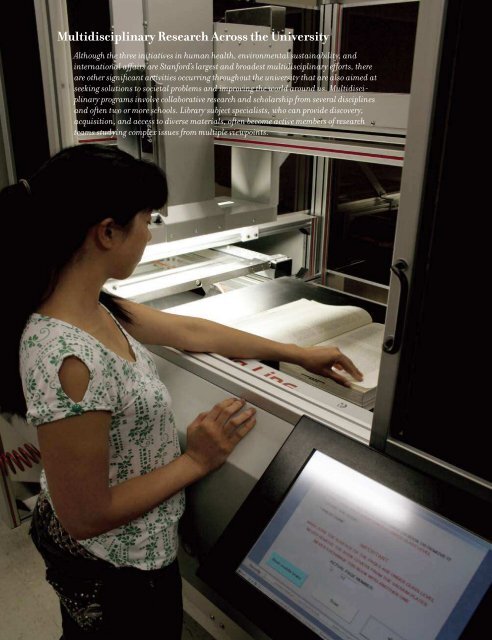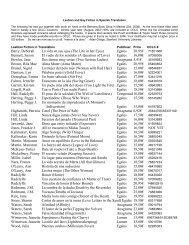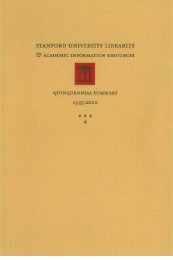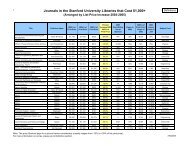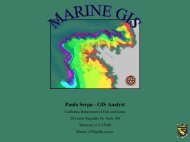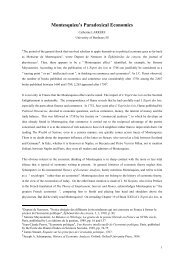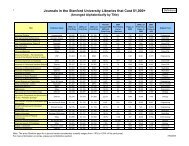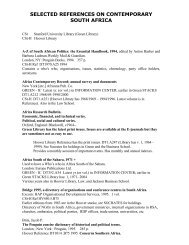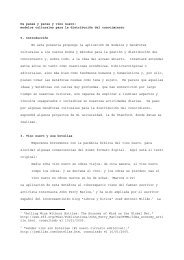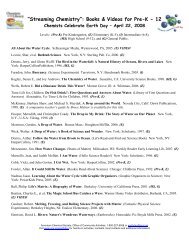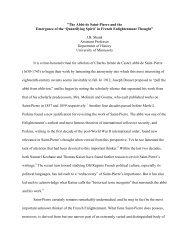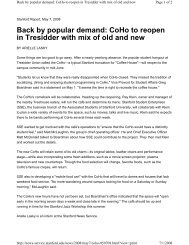The Challenge - Stanford University Libraries & Academic ...
The Challenge - Stanford University Libraries & Academic ...
The Challenge - Stanford University Libraries & Academic ...
You also want an ePaper? Increase the reach of your titles
YUMPU automatically turns print PDFs into web optimized ePapers that Google loves.
Multidisciplinary Research Across the <strong>University</strong><br />
Although the three initiatives in human health, environmental sustainability, and<br />
international affairs are <strong>Stanford</strong>’s largest and broadest multidisciplinary efforts, there<br />
are other significant activities occurring throughout the university that are also aimed at<br />
seeking solutions to societal problems and improving the world around us. Multidisciplinary<br />
programs involve collaborative research and scholarship from several disciplines<br />
and often two or more schools. Library subject specialists, who can provide discovery,<br />
acquisition, and access to diverse materials, often become active members of research<br />
teams studying complex issues from multiple viewpoints.<br />
Geographic Information Systems (GIS) Across Campus<br />
Branner Earth Sciences Library and Map Collections and the<br />
Social Sciences Data Center in Green Library provide support<br />
for patrons using Geographic Information Systems (GIS). GIS<br />
are a suite of hardware, software and data that allow a user to<br />
build multi-layered maps based upon the similarity of geographic<br />
space. <strong>The</strong> layers of disparate data are then queried<br />
to elucidate complex relationships between the information<br />
displayed in a graphical format. Patterns become apparent<br />
that would not have been readily seen were the data displayed<br />
in another form. This set of tools is used widely across campus<br />
by faculty and students in the fields of epidemiology, earth<br />
sciences, archaeology, anthropology, business, urban planning,<br />
engineering, and conservation biology. As the hub of<br />
GIS support on campus, the <strong>Libraries</strong> foster and enhance their<br />
use across a wide variety of disciplines and in all the schools;<br />
an important consideration as work becomes increasingly<br />
multidisciplinary across campus.<br />
Julie Sweetkind-Singer<br />
Head, Branner Earth<br />
Sciences Library<br />
Spoken Word Archive of Contemporary Thinkers Michael Toms<br />
and Justine Willis Toms, Co-Founders and Co-Presidents<br />
of New Dimensions Broadcasting Media Network, donated<br />
the entire New Dimensions archive to the <strong>Stanford</strong> <strong>University</strong><br />
<strong>Libraries</strong>. Comprising 35 years, about 6,000 hours, of recordings<br />
heard on public radio throughout the world, the recordings<br />
include interviews with the Dalai Lama, Krishnamurti,<br />
Linus Pauling, Joseph Campbell, Timothy Leary, Deepak Chopra,<br />
Bill Moyers, Alice Walker, Maya Angelou and about 3,000<br />
others. New Dimensions’ guests have included leaders whose<br />
papers are archived at <strong>Stanford</strong>, including utopian architect<br />
and thinker R. Buckminster Fuller and Stewart Brand, creator<br />
of <strong>The</strong> Whole Earth Catalog, thus creating a rich, multimedia<br />
trove of opportunities for students to explore the spoken and<br />
written words of these important thinkers, as well as to incorporate<br />
the spoken word into their own course projects.<br />
Roberto Trujillo<br />
Head, Department of Special<br />
Collections and Field Curator<br />
for Special Collections<br />
Opposite<br />
A technician sets up<br />
a book to be automatically<br />
scanned by<br />
<strong>Stanford</strong>’s page-turning<br />
robot.<br />
Top<br />
Many sorts of maps<br />
are housed in the<br />
Branner Earth Sciences<br />
Library along with<br />
extensive geo-referenced<br />
digital data.<br />
Financial Mathematics: A Case Study in Interdisciplinary Degrees<br />
<strong>The</strong> Interdisciplinary Master of Science Degree in Financial<br />
Mathematics is a relatively new program that requires carefully<br />
coordinated support from the <strong>Libraries</strong>. Most graduates<br />
of the program find positions as quantitative modelers and<br />
traders at investment banks and hedge funds. Faculty from<br />
four departments – Mathematics, Statistics, Economics, and<br />
Management Science & Engineering – as well as the Graduate<br />
School of Business plan the curriculum and course offerings.<br />
<strong>The</strong> program also sponsors a well attended Financial Mathematics<br />
Seminar open to the public. <strong>The</strong> 2006-2007 series<br />
featured academic speakers from Columbia, Chicago, Princeton,<br />
London and Zurich and leading industry speakers from<br />
Credit Suisse, Bloomberg, and the Federal Reserve Board,<br />
among others. In response to student and faculty requests,<br />
the Math Library has begun an acquisition program for select<br />
titles in Financial Mathematics.<br />
Linda Yamamoto<br />
Head, Mathematical &<br />
Computer Sciences Library<br />
Middle<br />
A selection of New<br />
Dimensions archival<br />
recordings hints at<br />
the variety of topics<br />
covered.<br />
Bottom<br />
Much used volumes<br />
of the Annuals of Mathematical<br />
Statistics.<br />
14 15


